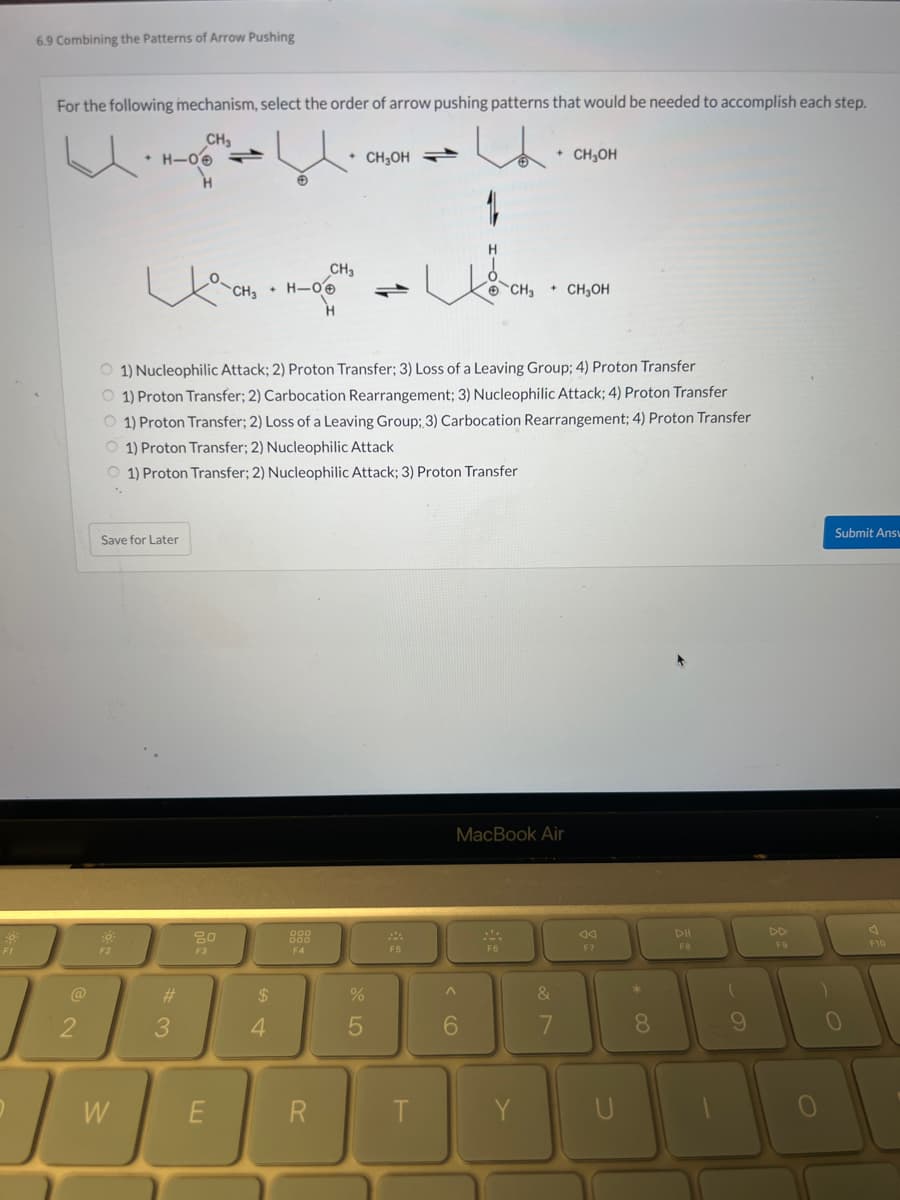For the following mechanism, select the order of arrow pushing patterns that would be needed to accomplish each step. CH₂ +H-OⓇ цасно + CH₂ H-OⓇ CH₂OH 1 + CH₂OH + CH₂ CH₂OH 1) Nucleophilic Attack; 2) Proton Transfer; 3) Loss of a Leaving Group; 4) Proton Transfer 1) Proton Transfer; 2) Carbocation Rearrangement; 3) Nucleophilic Attack; 4) Proton Transfer 1) Proton Transfer; 2) Loss of a Leaving Group; 3) Carbocation Rearrangement; 4) Proton Transfer 1) Proton Transfer; 2) Nucleophilic Attack 1) Proton Transfer; 2) Nucleophilic Attack; 3) Proton Transfer
For the following mechanism, select the order of arrow pushing patterns that would be needed to accomplish each step. CH₂ +H-OⓇ цасно + CH₂ H-OⓇ CH₂OH 1 + CH₂OH + CH₂ CH₂OH 1) Nucleophilic Attack; 2) Proton Transfer; 3) Loss of a Leaving Group; 4) Proton Transfer 1) Proton Transfer; 2) Carbocation Rearrangement; 3) Nucleophilic Attack; 4) Proton Transfer 1) Proton Transfer; 2) Loss of a Leaving Group; 3) Carbocation Rearrangement; 4) Proton Transfer 1) Proton Transfer; 2) Nucleophilic Attack 1) Proton Transfer; 2) Nucleophilic Attack; 3) Proton Transfer
Chapter16: Chemistry Of Benzene: Electrophilic Aromatic Substitution
Section16.SE: Something Extra
Problem 30MP: The carbocation electrophile in a Friede1-Crafts reaction can be generated by an alternate means...
Related questions
Question

Transcribed Image Text:F1
6.9 Combining the Patterns of Arrow Pushing
For the following mechanism, select the order of arrow pushing patterns that would be needed to accomplish each step.
CH₂
u.
·Ų.
+
2
+H-0
F2
Save for Later
W
u
H
#
3
80
F3
-CH3
E
+
O 1) Nucleophilic Attack; 2) Proton Transfer; 3) Loss of a Leaving Group; 4) Proton Transfer
1) Proton Transfer; 2) Carbocation Rearrangement; 3) Nucleophilic Attack; 4) Proton Transfer
1) Proton Transfer; 2) Loss of a Leaving Group; 3) Carbocation Rearrangement; 4) Proton Transfer
1) Proton Transfer; 2) Nucleophilic Attack
1) Proton Transfer; 2) Nucleophilic Attack; 3) Proton Transfer
$
4
H-OⓇ
H
CH3
000
000
F4
R
%
LO
CH₂OH
5
-
F5
T
^
CH₂
6
MacBook Air
F6
+ CH₂OH
Y
+ CH₂OH
&
7
F7
U
8
DII
FB
(
9
F9
Submit Answ
0
F10
Expert Solution
This question has been solved!
Explore an expertly crafted, step-by-step solution for a thorough understanding of key concepts.
This is a popular solution!
Trending now
This is a popular solution!
Step by step
Solved in 2 steps with 1 images

Knowledge Booster
Learn more about
Need a deep-dive on the concept behind this application? Look no further. Learn more about this topic, chemistry and related others by exploring similar questions and additional content below.Recommended textbooks for you


Organic Chemistry
Chemistry
ISBN:
9781305580350
Author:
William H. Brown, Brent L. Iverson, Eric Anslyn, Christopher S. Foote
Publisher:
Cengage Learning

Organic Chemistry: A Guided Inquiry
Chemistry
ISBN:
9780618974122
Author:
Andrei Straumanis
Publisher:
Cengage Learning


Organic Chemistry
Chemistry
ISBN:
9781305580350
Author:
William H. Brown, Brent L. Iverson, Eric Anslyn, Christopher S. Foote
Publisher:
Cengage Learning

Organic Chemistry: A Guided Inquiry
Chemistry
ISBN:
9780618974122
Author:
Andrei Straumanis
Publisher:
Cengage Learning